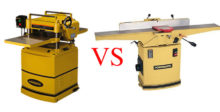Which Comes First: Planer or Jointer?
Article - October 24, 2007
I recently received an email from Doug who asked a very good question concerning some major power tool purchases.
I only have the money to buy one tool at a time with months in between purchases. If you were going to choose between a planer and jointer, which one would come first? – Doug
 Most woodworkers know that you need both a planer and a jointer to get the most out of rough lumber (at least for power tool users). The jointer is used to flatten one face and square up one edge and the planer is then used to make the second face flat and parallel to the first. To learn more about this process, check out this video on Milling Lumber. Given that these tools are very expensive, it isn’t surprising that most of us will only be able to afford one tool at a time. So deciding which one comes first could mean the difference between having a useful new tool in your shop and having a decoration that collects dust in the corner until its partner arrives.
Most woodworkers know that you need both a planer and a jointer to get the most out of rough lumber (at least for power tool users). The jointer is used to flatten one face and square up one edge and the planer is then used to make the second face flat and parallel to the first. To learn more about this process, check out this video on Milling Lumber. Given that these tools are very expensive, it isn’t surprising that most of us will only be able to afford one tool at a time. So deciding which one comes first could mean the difference between having a useful new tool in your shop and having a decoration that collects dust in the corner until its partner arrives.
In my opinion, you should purchase the planer first. You’ll be able to accomplish more with it on its own than you can with a jointer. The jointer excels at making one flat face and one square/flat edge and that’s about it. If you run the other rough face on the jointer, you can certainly make it flat but you won’t make it parallel to the first face. That makes for a board that’s thicker at one end than the other. And speaking of thickness, a jointer will not allow you to easily thickness boards to a precise dimension. A planer on the other hand was born for the task of thicknessing. If you purchase pre-milled stock you’ll be able to make the boards any thickness you want.
But what if you don’t want to use pre-milled stock and your boards are rough. Good news! The planer can help you there too. As long as your rough boards are fairly straight, you can send them through the planer taking alternating light passes on each side. Once both faces are clean, they should be flat and mostly parallel. Of course your edges will still be rough. To clean those up you have several options: trim with a circular saw and a saw guide, trim at the table saw with a jointing jig, trim with a hand plane, or trim at the router table. Admittedly none of these solutions are perfect but remember, this is a temporary situation. Eventually you’ll have both the planer and the jointer and 4-square boards will be just minutes away. Until then, the planer will provide a lot of additional functionality that can make a real difference in your productivity.
But that’s just my opinion. I think Doug would be best served hearing everyone’s opinions about this common situation. So what would you find most useful on it’s own, the planer or the jointer?



